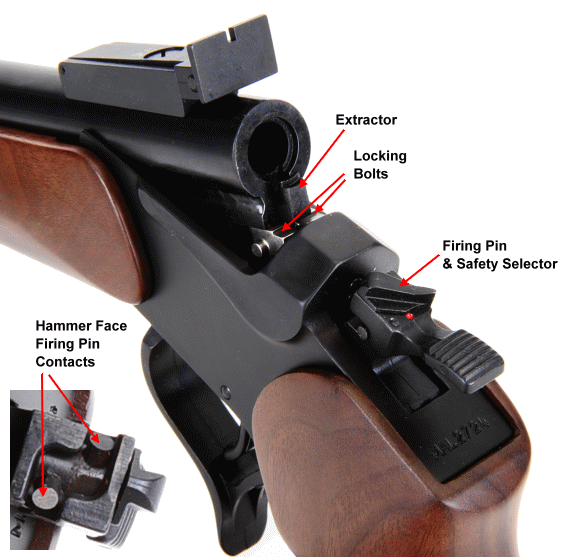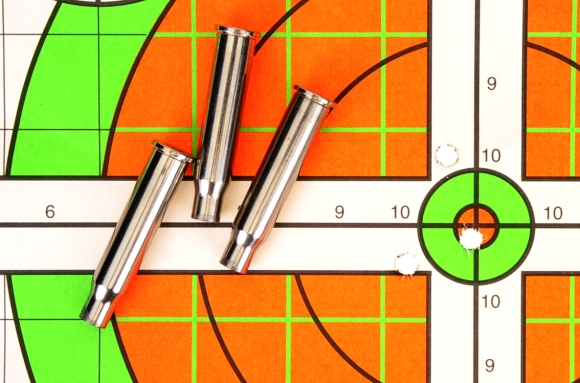
Creative genius in people seems to manifest itself as the good ideas many people have, but with an ability to turn those good ideas into successful realities. The combination of Thompson / Center Contender and 7-30 Waters cartridge seems to be a culmination of lots of good ideas, although I am not sure either evolved to serve their original intent.
An early version of the Contender, left. Current version, G2, right. The early version has been retro labeled the G1, however, that was never public model nomenclature while it was in production. Warren Center designed the Contender to serve his interests as a varmint hunter. In 1964, Center reviewed his design to Ken Thompson, K.W. Thompson Tool Company, and by 1967 the Contender was in production at the newly formed Thompson / Center Arms Company 1).
In 2007, Thompson/Center was acquired by Smith & Wesson for $102 million in cash. In 2010, manufacturing was moved from Rochester, New Hampshire to Smith & Wesson facilities in Springfield MA. Thompson/Center has done some innovative things with firearm design since its inception, including bolt action rifles, muzzle loaders and single shot pistols, which seems to have changed little since the acquisition and consolidation.
Changes of evolution; significant, but not revolution
The first version of the Contender, with several design revisions, ran from 1967 through 1995, then it was followed by the G2. The early version on the left was manufactured between January and June of 1971 and purchased shortly thereafter.

The early Contender grip is swept back 110° from bore centerline, the G2 grip angle is 115°. The early Contender has a 10″, hex shaped barrel chambered for the 222 Remington; typical configuration of that day. The G2 has a 14″ bull barrel chambered for the 7-30 Waters, typical of today and reflective of the pistol’s evolution. What began as a varmint pistol with moderate cartridges, compact and light weight, became a pistol well suited to competitive long range pistol shooting and medium to big game hunting.
Neither the original Contender or the G2 version are made for high intensity cartridges. That assignment has been designated to the T/C/ Encore. As seen below, original Contender top, G2 Bottom, in addition to the grip angle change, the early version has an adjustable trigger and overtravel stop, the G2 does not. However, the G2 has an improved fire control mechanism that allows the hammer to be recocked without opening and closing the action if the hammer has been decocked with the safety engaged.

Where the early Contender has a slick, slab sided receiver with threatening cougars preparing to leap from a rocky precipice, the G2 has sculptured, beefed up chamber walls for a more… avant-garde presence. Both very important if you hunt with hipsters. For the more pragmatically grounded shooter, the early Contender’s receiver walls are 0.050″, while the G2 receiver walls measure 0.130″. Both have a common dimension 0.510″ thick breech face.
I do not think this change was to add strength to the chamber area to resist greater pressure, as much as it added strength to reinforce the action against stretching under rearward cartridge thrust. Whatever the applicability of my theory, the barrels are interchangeable between versions. I saw a replacement parts listing as “early version hinge pin, 0.374″ diameter” which is curious as the early hinge pin is 0.374″ in diameter, while the G2 version is… 0.374″ in diameter and the width, 0.920″ is the same.

The G2 action is very slick compared to the original. When it was new, my early Contender used to require a judo chop on the trigger guard spur to open the action. After some time, and a diet of my handloads, it became a two finger, sharp snap operation. The new G2 just take a very smooth rearward tug on the spur and the barrel flops down.
Hammer…ers
The early Contender has a cross bolt safety that causes a pin to protrude from the hammer face when engaged, and prevents the hammer face from contacting the frame mounted firing pin. In this very early version, a screw driver is used to rotate the hammer face insert to change it from rimfire to centerfire strike.

The G2 locates the safety and firing pin selection function into one control. When centered, the selector protrudes forward and prevents the hammer from going full travel and contacting the firing pin. Turning the selector left or right rotates a drum with two contact surfaces within the hammer and selects rimfire or centerfire firing pin contact. See picture inset.

The G2 hammer rest position is off the firing pin, where it returns after discharge and the trigger is reset. The early version moves off the firing pin when the action is opened and then closed, then it is pulled full back to cock the hammer to fire. In discharge, the hammer is flush against the breech and remains as the trigger does not reset until the action is again opened and closed. And on that note, we will leave the old timer behind… the pistol, not me, and carry on with the current G2 Contender.
Barrels…
Barrel changing easy. After making sure the pistol is empty, close action, safety in rest position and safety on. Remove two screws securing the forend and remove forend. There are actually seven types available, rubber or walnut, to match up with barrel length and barrel profile.

The action is opened and the hinge pin is pushed out.

The barrel lifts off and separates from the receiver. Installation is just a reverse of the same.

The pin is a tight, slip fit and does not require thumping to come out. If the pin feels tight, it is typically because the pin is loaded from barrel angle or lack of support to take weight off of the pin. If the pistol is very new, it might take a tap from a very light nylon head hammer on a nylon punch to get it started in motion.
Overview
|
Thompson/Center G2 Pistol 7-30 Waters |
|
| Manufacturer | Thompson/Center |
| Model Frame |
#08028700 |
| Type | Break Action |
| Barrel 7-30 Waters |
#06144527 |
| Capacity | 1 |
| Barrel Length | 14“ |
| Rifling | 1:9″ |
| Weight | 3 lbs 11 oz |
| Overall Length | 18 1/2″ |
| Stock | Walnut |
| Hardware | Blued Steel |
| Sights | Adjustable W/E |
| Scope Mounting |
Drilled & Tapped |
| Safety | Hammer Rotary |
| MSRP | $523 Frame + $399 Barrel |
Contenders may be purchased as complete frame and barrel combination or as a frame with barrels ordered À la carte. Does anyone even know what that term means anymore? Gees I am old. Anyway, other than custom barrels and out of production early chambers, the current line up of pistol barrels is: 17 HMR, 22 LR Match, 204 Ruger, 223 Rem, 6.8 Rem, 7-30 Waters, 30-30 Win, 357 Mag, 44 Rem Mag, 45/70 Govt, 45 Colt / 410 Bore with removable choke. Moderate pressure and/or low bolt thrust cartridges, but still well beyond the original chambers of 22 LR, 22 Hornet and 38 Special.
I’ve read the frame is good for 48,000 psi, but that is not a spec as 55,000 PSI from a 223 Remington round is clearly less stress and strain than 48, 000 psi from a 45-70 round with a large case head. So I stick with factory ammo or equivalent handloads and keep 45-70 loads to SAAMI spec, not high pressure versions.
Looking through mainstream reloading manuals, like Sierra’s and Hornady’s, that have T/C Contender specific load data, they set loads at an intensity halfway between the lightest Trapdoor rifle loads and the Winchester 1886 or Marlin 1895. That suggests that 48,000 psi as a blanket limit would be inappropriate, so stick with well tested data and avoid the equivalent of taking candy from strangers in social media.
I think the reasons for owning a Thompson/Center Contender remains the same as they have been over the years. I bought mine in 1971 because I very recently had competed military family, had a young family and tight budget. The Contender of that time allowed me to develop reloading skills, gain experience with a wide variety of cartridges and develop shooting skill. For folks who like to spend time at the range competing, or out in the woods hunting with a handgun, the Contender is uniquely qualified.
Shaking off the cobwebs…
Shooting a Contender is probably very intuitive to anyone experienced with single shot pistols, but it may take some practice for others to gain proficiency. For me, it’s been a while so practice will be required, and probably scope mounting, to present a fair picture of the Contender’s potential. I did not want to close, however, without a comment on live fire.
Below is a target that represents the first, second and third shots out of this Contender. The next three shots went over the chronograph averaging 2,417 fps through the pistol’s 14″ barrel, compared to a 2,700 fps SAAMI 24″ test barrel standard. The distance was 50 yards, using the pistol’s metallic sights. I have not shot a Contender for some time… years, and my eyesight is not optimal for this kind of shooting. Still, 1 1/4″ isn’t a bad place for me to start and to get a feel for shooting this combination.

There is currently only one manufacturer making factory ammo for the 7-30 Waters, Federal Vital-Shok with 120 grain Sierra GameKing bullet. Only one company offers new brass, Quality Cartridge Brass, at a ridiculous price… 50% more than loaded ammunition. So Federal ammo not only makes sense for factory ammo, it also serves as a good source of reloadable brass. Which all plays into the essence of the T/C Contender; a handloader’s combination. It is extremely easy to fabricate 7-30 Waters brass; run plentiful and inexpensive 30-30 Win brass through a 7-30 Waters sizer die and fire form it in the pistol’s chamber. Things we will cover in detail in Part II.
For now, the Thompson/Center G2 Contender is comfortable to shoot with even this relatively stout cartridge. The grip is hand filling and allows excellent control. The barrel weight dampens recoil and its length produces good velocity. Recoil is sharp, but not bad at all. The current grip angle takes the joy of finger rapping on the trigger guard that I found so rewarding when shooting my early Contender. Nice firearm… and interesting.

1) Thompson/Center Contender Pistol – How to Tune, Time, Load and Shoot for Accuracy – Charles Stephens

Email Notification